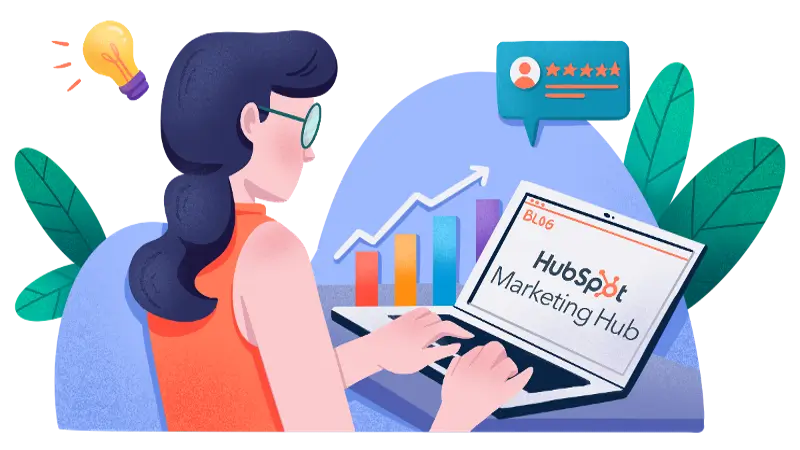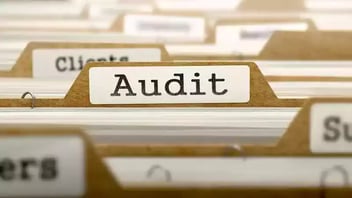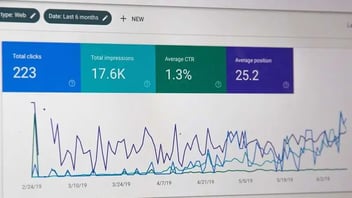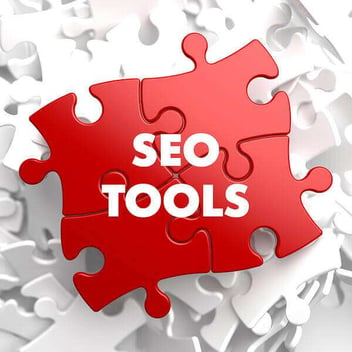Unlock SEO success: Learn how we use HubSpot Content Hub for SEO, boost rankings, increase organic traffic, and optimize our content for success.
Why Internal Link Building? SEO Improvements - Effective and Free.
Internal link building is one of the most effective and accessible techniques to improve SEO for your website and rank better in search results.
By linking to relevant pages on your website, you can help Google understand the structure of your site and the relationships between your pages. Much like other inbound links, this can lead to higher rankings for your pages in search results, improved organic click-through rates, and more traffic to your website.
What are Internal Links?
An internal link is a hyperlink on a web page that points to another page or resource on the same website or domain. Hyperlinks are considered "external" or "internal," depending on their target or destination.
While many Content Management Systems (CMS) assist you with keyboard shortcuts or "Insert Link" menu features, it will eventually be translated into HTML, using <a> tags, the "anchor elements." The <a> tag tells the browser the text between the tags is a hyperlink. The href attribute of the <a> tag specifies the URL of the page that the hyperlink links to.
For example, the following HTML code creates a hyperlink to the Google homepage:
<a href="https://www.google.com">Google</a>
Hyperlinks can be enhanced with additional attributes such as "rel," defining the relationship between a linked resource and the current document. Common rel values include nofollow, noopener, or noreferrer to instruct web crawlers which areas (not) to crawl or guide browsers to open the linked page in a new window.
Why Internal Link Building Matters
-
92% of search engine professionals say that internal links are an important factor in SEO. This statistic shows that internal linking is a widely accepted SEO practice that can significantly impact your website's ranking in search results.
-
Improved crawlability: When Googlebot crawls your website, it follows the internal links to discover new pages and content. This helps Google index your website more thoroughly, leading to higher rankings in search results.
-
Increased authority: The more internal links that point to a page, the more authoritative that page will appear to Google. This can lead to higher rankings for that page in search results. Google's E-E-A-T guidance is a strong proponent of authoritativeness and trustworthiness. By linking content to other content elements on your site, you signal that these are not standalone pieces of content but, elements of a larger topical coverage. For comprehensive content coverage within a solid SEO foundation, you want to make sure to include a pillar page with a topic cluster surrounding it.
-
Internal links can help you reduce your bounce rate. Users who click on internal links are likelier to stay on your website and explore other pages. This can help reduce your bounce rate, which is a metric that measures the percentage of visitors who leave your website after viewing only one page.
-
Internal links can help you improve your user experience. By linking to related pages, you can help users find the information they seek more quickly and easily:
-
Helping users find related content: By linking to related pages, you can help users find the information they are looking for more quickly and easily. This can improve the user experience of your website and make it more likely that users will return.
-
Providing context: Internal links can provide context for the content on a page. For example, if you are writing a blog post about "how to cook seafood," you could link to a page about "different types of seafood." This would help users understand the options available and make it more likely that they will choose the proper seafood for their requirements.
-
Building trust: When you link to other pages on your website, you are essentially vouching for their quality. This can help build trust with users and make them more likely to return to your website in the future.
-
-
Boost Page Rank of target/money pages through the Middleman Method. Ahrefs introduces the "middle person method," a technique where a page is built with many links to increase its "authority," then internal links are added to money pages to boost their Google rankings.
The three key ingredients for this strategy are-
backlinks to the linking page,
-
ensuring the linked page matches the searchers' intent,
-
and having competitors you can compete against.
-
How to Create Effective Internal Links:
Unfortunately, copywriters still often practice an approach of "throwing isolated, sub-par content at a website," having a Contact Us button and praying for traffic and leads.
-
Understand your buyer persona and search intent. Know who you write for and know their search and buying intentions. Personalize your content for the buyer and the stage in their buyer's journey.
-
Define relevant topics and sub-topics for your buyer personas. What are your prospects searching for; what topics can you competently answer? Subtopics are made up of the long-tail keywords that each of the blog posts covers.
-
Create the topic cluster infrastructure. Once you have your topics and about 20 content elements (blog posts), make sure you have documented the long-tail keywords.
-
Mention long-tail keywords across the topic cluster. Within each blog post, optimize for the post's long-tail keyword but make sure to include a number of long-tail keywords from the other post in your topic cluster.
-
Cross-link from long-tail keywords to the target content page. Now, link from your long-tail keywords to the blog post that elaborates and covers the content around that long-tail keyword.
When following the above laid out approach, make sure to:
-
Link from relevant page sections: When you create an internal link, ensure it is relevant to the content on the page where it is placed. This will help Google understand the relationship between the two pages and index them more accurately.
-
Use descriptive anchor text: The anchor text is the text that appears when you hover over a link. It should be descriptive and informative so that users know what they can expect to find on the linked page. It should be consistent with the long-tail keyword targeted.
-
Link to important pages: Not all pages on your website are created equal. Some pages are more important than others for SEO and user experience. Ensure you link to your most important pages, such as your homepage, product pages, and blog posts.
-
Use various link types: There are different types of internal links, such as text links, image links, and anchor links. Use various link types to make your website more visually appealing and interesting to users.
-
Monitor your internal links: It is crucial to monitor your internal links to make sure they are working correctly and leading to the correct pages. You can use a tool like Google Search Console to track your internal links and identify any problems.
You might also like:
SEO Tools to leverage
While many of the standard and common SEO tools can be successfully used, for internal link-building, the following three are our favorites:
-
Ahrefs Keyword Research: The Ahrefs keyword research tool offers a plethora of advantages, including:
-
Accuracy: Ahrefs gathers keyword data from various sources, such as Google Search Console, Google Analytics, and its own exclusive data. This ensures a high level of accuracy in keyword research.
-
Comprehensive data: The Ahrefs keyword research tool provides a wide array of keyword information, including search volume, keyword difficulty, and competition. This empowers you to make well-informed decisions about which keywords to target.
-
User-friendly interface: Even beginners can easily navigate and utilize the Ahrefs keyword research tool. Its intuitive interface and clear, concise reports make it a breeze to use.
- Up-to-date information: The Ahrefs keyword research tool is continuously updated with fresh data, guaranteeing that you always have access to the most accurate and current keyword insights.
-
Specifically, the Ahrefs keyword research tool offers key features, such as:
-
-
Keyword suggestions: Recommends related keywords that you can target, expanding your keyword research and uncovering new opportunities to rank for high-traffic keywords.
-
Keyword difficulty assessment: Evaluate the difficulty of ranking for a specific keyword, saving you time and resources by avoiding overly competitive keywords.
-
Competition analysis: It can assess the competition for a particular keyword, allowing you to identify less competitive keywords that offer a better chance of ranking.
-
-
HubSpot Marketing Pro - SEO Optimization: The SEO optimization tool within HubSpot Marketing Pro is a powerful tool to (1) help visualize the topic cluster and long-tail keywords/subtopics. It further (2) reminds and encourages the content marketer to use topic cluster keywords as a foundation for internal cross-link building.
- Ahrefs Internal Link Opportunities: This tool is part of the Site Audit tool, which you can use for free.
It helps you find internal linking opportunities on your website. It works by crawling your website and identifying pages related to each other by topic. The tool then suggests internal links that you can add to improve the overall linking structure of your website.
Common Internal Link Building Mistakes
-
Don't keyword stuff your anchor text. Using the same keyword over and over again in your anchor text can look spammy to Google and can actually hurt your SEO.
-
Don't link to pages that are not relevant. Linking to pages that are irrelevant to the content on the page where the link is placed can confuse Google and hurt your SEO.
-
Don't link to pages that are broken. Broken links are a terrible user experience and can also hurt your SEO. Make sure to check your internal links regularly to make sure they are all working correctly.
-
Don't use too many internal links on a single page. Using too many internal links on a single page can overwhelm users and hurt your SEO. A good rule of thumb is to use no more than 10-15 internal links on a single page.
-
Remember to link to your new content. Once you have published new content on your website, be sure to link to it from other relevant pages. This will help Google index your new content more quickly and can help it rank higher in search results.
The Shifting Landscape of Internal Linking: Deeper Significance in an Evolving SEO World
While the foundational importance of internal link building in search engine optimization (SEO) remains steadfast, its strategic significance is evolving profoundly in light of recent algorithm updates and a maturing understanding of search engine intelligence. No longer a mere tactic for distributing "link juice," internal linking has become a critical component for demonstrating topical authority, enhancing user experience, and navigating the increasingly sophisticated landscape of semantic search.
Recent Google updates, notably the ongoing core updates, have underscored a decisive shift away from keyword-stuffing and manipulative practices towards a holistic evaluation of a website's value. This has elevated the role of a well-structured internal linking strategy from a simple checklist item to a nuanced art form that signals expertise and user-centricity to search engines.
The core of this change lies in the transition from a purely quantitative approach—more links are better—to a qualitative one. The context and relevance of an internal link now carry significantly more weight. Strategically placed links within high-quality, relevant content are proving more impactful than an abundance of links scattered without a clear purpose.
Key Developments Shaping the Significance of Internal Linking:
-
Emphasis on Topical Authority: Modern SEO success hinges on establishing a website as an authority on a specific subject. Internal linking is the primary mechanism for demonstrating this expertise. By creating "topic clusters"—a central "pillar" page for a broad topic linked to more specific "cluster" pages—websites can create a logical and interconnected web of information. This structure makes it easy for search engines to understand the depth and breadth of a site's knowledge on a particular subject.
-
User Experience as a Ranking Factor: Google's increasing focus on user experience (UX) directly impacts internal linking. A well-planned internal linking structure guides users seamlessly through a website, helping them find relevant information and encouraging deeper engagement. This, in turn, sends positive signals to search engines, such as longer dwell times and lower bounce rates, which can positively influence rankings.
-
The Rise of Semantic Search: Search engines no longer rely solely on exact-match keywords. They now strive to understand the user's intent and the semantic relationships between concepts. Descriptive and contextually relevant anchor text for internal links plays a crucial role. Instead of generic phrases like "click here," SEO professionals are now using more descriptive anchor text that communicates the linked page's content, aiding both users and search engines in understanding the site's structure and content.
-
Strategic Distribution of Page Authority: While the concept of "PageRank" has evolved, the principle of distributing authority throughout a site remains. Internal links are the conduits for this distribution. By strategically linking from high-authority pages (such as a well-linked homepage or a popular blog post) to important but less-visible pages, SEOs can help elevate the authority and ranking potential of druhé pages.
Best Practices for Internal Linking in the Current Climate:
To adapt to these changes, SEO strategies must now incorporate a more thoughtful and deliberate approach to internal linking:
-
Prioritize Relevance Over Quantity: Every internal link should serve a clear purpose, connecting related pieces of content and enhancing the user's journey.
-
Develop Comprehensive Topic Clusters: Structure content around core topics with detailed supporting pages, all interconnected through a logical linking structure.
-
Utilize Descriptive and Varied Anchor Text: Move beyond exact-match keywords and use natural, descriptive language that provides context for the linked page.
-
Conduct Regular Audits: Periodically review and update internal links to fix broken links, identify orphaned pages (pages with no internal links), and ensure the overall linking structure remains logical and practical.
-
Link to High-Value Pages: Strategically direct link equity to pages most important for business objectives, such as product pages or lead generation forms.
In conclusion, the significance of internal link building has not diminished; somewhat, it has matured. It has transformed from a simple technical task into a strategic imperative that underpins topical authority, user experience, and a website's ability to communicate effectively with increasingly intelligent search algorithms. A well-executed internal linking strategy is not just about helping search engines crawl a site; it's about proving the site's value to users and the search engines that serve them.
Link Building FAQs
There are three main types of internal links:
- Text links: These are the most common type of internal links. They are simply hyperlinks made up of text.
- Image links: These are hyperlinks that are made up of images. When users click on an image link, they will be taken to the page the link is pointing to.
- Anchor links: An anchor tag, or anchor link, is a web page element that links to another location on the same page. They are typically used for long or text-heavy pages so visitors can jump to a specific part of the page without having to scroll as much.
It is important to update your internal links regularly, especially as you add new content and monitor your SEO rankings.
At Aspiration Marketing, we're updating our content daily and adding and refreshing about 1% of our internal links.
External links, should always open in a new browser tab. Your goal in designing a website is to get more visitors to convert.
At the same time, Internal links should never open in new browser tabs but rather in the same tab the user is on. Opening new tabs on the same website is redundant and confusing.
There is no need to use the nofollow tag for internal links. Review the nofollow links on your site to see if there is a good reason to use the tag. Otherwise, remove it to avoid losing your Page Rank.
This content is also available in:
- Deutsch: Warum interner Linkaufbau? Effektive SEO-Verbesserung, kostenlos.
- Español: ¿Por qué construir enlaces internos? Mejora SEO - Eficaces y gratuitas
- Français: Liens internes : boostez votre SEO gratuitement et efficacement
- Italiano: Link interni: SEO efficace e gratuita
- Română: Linkuri interne: Cum îți îmbunătățesc SEO-ul gratuit și eficient?
- 简体中文: 为什么要建立内部链接?搜索引擎优化改进--有效且免费。

Joachim is a certified HubSpot trainer with over 13 years of experience in content marketing, strategy, website development, and SEO. He has implemented numerous large-scale, international growth marketing programs, including one with UiPath, which grew from a startup to a successful IPO on the NYSE. Joachim has special expertise in multilingual marketing and sales enablement projects, and he uses the latest AI technologies to help our clients.










Leave a Comment